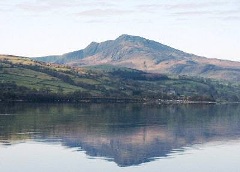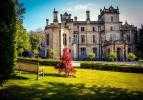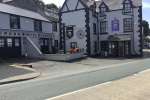- Home ›
- North Wales ›
- Gwynedd ›
- Hotels in Bala ›
- Page 1
Hotels in Bala Gwynedd
 Bala is a small but historically rich market town located in the Gwynedd council area of Wales. It is nestled on the edge of the spectacular Snowdonia National Park, and along the shores of Bala Lake (or Llyn Tegid), which is the largest natural lake in Wales. Known for its breathtaking natural beauty and a plethora of outdoor activities, the town is a popular destination for both tourists and nature enthusiasts seeking a tranquil and scenic getaway. From historical streets to scenic trails, Bala offers a rich canvas of experiences, seamlessly blending its ancient heritage with vibrant modern culture.
Bala is a small but historically rich market town located in the Gwynedd council area of Wales. It is nestled on the edge of the spectacular Snowdonia National Park, and along the shores of Bala Lake (or Llyn Tegid), which is the largest natural lake in Wales. Known for its breathtaking natural beauty and a plethora of outdoor activities, the town is a popular destination for both tourists and nature enthusiasts seeking a tranquil and scenic getaway. From historical streets to scenic trails, Bala offers a rich canvas of experiences, seamlessly blending its ancient heritage with vibrant modern culture.Visitors in Bala are greeted with a wide array of attractions that highlight both its natural beauty and historical prominence. One of the standout landmarks in the region is Bala Lake, a hub of recreational activities such as sailing, windsurfing, and fishing. The lake is also home to a rare species of fish called the Gwyniad, a living testimony to the ancient glacial history of the area. A visit to Bala would be incomplete without a ride on the Bala Lake Railway, a narrow gauge steam railway offering picturesque views of the lake and surrounding mountains. Not far from the town center stands the prominent Christ Church, a historical church showcasing stunning gothic revival architecture. For those interested in the regional history, St Deiniol's Church is another must-visit site, steeped in history dating back to the 14th century, serving as a window into the area's deep-rooted Christian heritage. Outdoor enthusiasts will appreciate the Aran mountain range to the south of Bala, offering challenging hikes and rewarding panoramic views from the summit.
The surrounding region of Bala is peppered with picturesque towns and attractions that beckon the curious explorer. To the north of Bala lies the town of Betws-y-Coed, a gateway to Snowdonia National Park, known for its beautiful waterfalls and the historic Pontcysyllte Aqueduct near Llangollen, a remarkable feat of engineering and a UNESCO World Heritage Site. Heading westward, visitors can explore Dolgellau, a charming town that offers a wealth of walking trails, including the famed Mawddach Trail with breathtaking views along the Mawddach Estuary. Machynlleth is also a popular destination for The Centre for Alternative Technology, both a visitor attraction and educational visit. Further northwest, the coastal town of Harlech awaits, home to the impressive Harlech Castle, a fortress that stands tall with an expansive view of the sea, beckoning history buffs with its rich past. Towards the east of Bala, the town of Corwen showcases a rich Celtic and medieval history, offering a range of historic sites, including the ancient ruins of Castell Caer Drewyn. Venturing further east, visitors will reach Llangollen, a picturesque town by the River Dee, renowned for hosting the Llangollen International Musical Eisteddfod, a festival bringing together a rich tapestry of music, dance, and artistic performances from around the world. Each nearby town enhances the rich array of experiences offered in the region, providing a delightful amalgamation of history, culture, and natural beauty, promising an enriching and vibrant exploration of this Welsh paradise.


Hotel
0.08 miles away
At the Hotel
Free Wifi
Parking
Restaurant
Coffee / Tea
Open all year
Bar
Breakfast
En-Suite
Shower
TV
Children Welcome
Within 5 Miles
Bar / Pub
Entertainment
Cycling
Walking
Fishing

Hotel
0.16 miles away
At the Hotel
Free Wifi
Free Parking
Restaurant
Coffee / Tea
Bar
Breakfast
En-Suite
Shower
TV
Family Rooms
Children Welcome
Within 5 Miles
Restaurant / Cafe
Bar / Pub
Entertainment
Cycling
Walking

Inn
0.21 miles away
At the Hotel
Free Wifi
Free Parking
Restaurant
Coffee / Tea
Open all year
Bar
Breakfast
En-Suite
Shower
TV
Meal options
Within 5 Miles
Restaurant / Cafe
Bar / Pub
Entertainment
Cycling
Walking

Bed and breakfast
1.04 miles away
At the Hotel
Wifi
Parking
Coffee / Tea
Breakfast
En-Suite
Shower
TV
Family Rooms
Children Welcome
Meal options
Garden
Within 5 Miles
Restaurant / Cafe
Bar / Pub
Entertainment
Cycling
Walking

Hotel
3.64 miles away
At the Hotel
Wifi
Free Parking
Restaurant
Electric charge point
Coffee / Tea
Open all year
Bar
Lift
Breakfast
Concierge
En-Suite
Within 5 Miles
Restaurant / Cafe
Bar / Pub
Entertainment
Cycling
Walking

Guest house
3.71 miles away
At the Hotel
Free Wifi
Free Parking
Coffee / Tea
Open all year
En-Suite
Shower
TV
Garden
Outdoor funiture
Access provisions
Within 5 Miles
Restaurant / Cafe
Bar / Pub
Entertainment
Cycling
Walking

Inn
3.82 miles away
At the Hotel
Free Wifi
Free Parking
Coffee / Tea
Open all year
Bar
Breakfast
En-Suite
Shower
TV
Meal options
Garden
Within 5 Miles
Restaurant / Cafe
Bar / Pub
Cycling
Walking
Fishing

Bed and breakfast
4.58 miles away
At the Hotel
Free Wifi
Free Parking
Coffee / Tea
Open all year
Breakfast
En-Suite
Shower
TV
Meal options
Adults Only
Garden
Within 5 Miles
Restaurant / Cafe
Bar / Pub
Entertainment
Cycling
Walking

Hotel
6.8 miles away
At the Hotel
Free Wifi
Free Parking
Restaurant
Coffee / Tea
Open all year
Bar
Breakfast
En-Suite
Shower
TV
Children Welcome
Within 5 Miles
Restaurant / Cafe
Bar / Pub
Entertainment
Fishing
Horse Riding

Inn
6.88 miles away
At the Hotel
Free Wifi
Restaurant
Coffee / Tea
Open all year
Bar
Breakfast
En-Suite
Shower
TV
Children Welcome
Childrens meals
Within 5 Miles
Restaurant / Cafe
Bar / Pub
Entertainment
Cycling
Walking

Bed and breakfast
8.01 miles away
At the Hotel
Free Wifi
Free Parking
Electric charge point
Coffee / Tea
Open all year
Breakfast
En-Suite
Shower
TV
Meal options
Adults Only
Within 5 Miles
Restaurant / Cafe
Bar / Pub
Entertainment
Mountain views
Garden views

Bed and breakfast
8.83 miles away
At the Hotel
Free Parking
Coffee / Tea
Open all year
Breakfast
En-Suite
Snack Bar
Shower
TV
Family Rooms
Children Welcome
Meal options
Within 5 Miles
Restaurant / Cafe
Bar / Pub
Garden views

Inn
8.85 miles away
At the Hotel
Free Wifi
Free Parking
Restaurant
Coffee / Tea
Open all year
Bar
Breakfast
En-Suite
Shower
TV
Children Welcome
Within 5 Miles
Restaurant / Cafe
Bar / Pub
Entertainment
Cycling
Walking

Guest house
9.28 miles away
At the Hotel
Free Wifi
Free Parking
Restaurant
Coffee / Tea
Open all year
Bar
Free Breakfast
TV
Meal options
Garden
Meeing Room
Within 5 Miles

Hotel
9.48 miles away
At the Hotel
Free Wifi
Free Parking
Restaurant
Coffee / Tea
Open all year
Bar
Breakfast
En-Suite
Shower
TV
Family Rooms
Within 5 Miles
Restaurant / Cafe
Bar / Pub
Entertainment
Cycling
Walking

Farm stay
9.74 miles away
At the Hotel
Free Wifi
Free Parking
Coffee / Tea
Open all year
En-Suite
Shower
Family Rooms
Children Welcome
Balcony Rooms
Garden
Outdoor funiture
Within 5 Miles
Restaurant / Cafe
Bar / Pub
Entertainment
Walking
Mountain views
Local Information
Located within a valley in the Snowdonia National Park
Located within a valley in the Snowdonia National Park

Inn
10.08 miles away
At the Hotel
Free Wifi
Free Parking
Restaurant
Open all year
Bar
Breakfast
En-Suite
Shower
TV
Family Rooms
Children Welcome
Within 5 Miles
Cycling
Walking

Hotel
10.64 miles away
At the Hotel
Free Wifi
Free Parking
Restaurant
Coffee / Tea
Open all year
Bar
Breakfast
En-Suite
Shower
TV
Family Rooms
Within 5 Miles
Restaurant / Cafe
Bar / Pub
Entertainment
Walking
Fishing

Hotel
10.68 miles away
At the Hotel
Free Wifi
Free Parking
Restaurant
Coffee / Tea
Open all year
Bar
Breakfast
En-Suite
Shower
TV
Family Rooms
Within 5 Miles
Restaurant / Cafe
Bar / Pub
Entertainment
Cycling
Walking

Guest house
10.84 miles away
At the Hotel
Free Wifi
Free Parking
Coffee / Tea
Open all year
Bar
Breakfast
En-Suite
Shower
TV
Family Rooms
Children Welcome
Within 5 Miles
Restaurant / Cafe
Bar / Pub
Entertainment
Cycling
Walking

